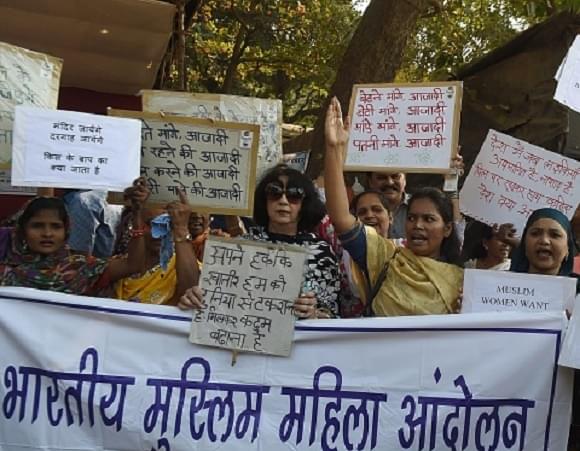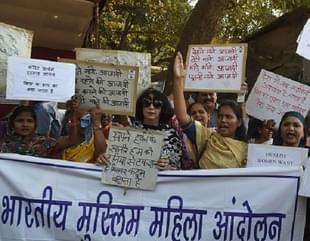Politics
The Afreen Rehman Talaq And The Opportunity For A Uniform Civil Code
Dr. Shonu Nangia
May 27, 2016, 03:05 PM | Updated 03:05 PM IST
Save & read from anywhere!
Bookmark stories for easy access on any device or the Swarajya app.


The unfortunate situation of Afreen Rehman, a modern, Indian Muslim woman, once again demonstrates that one of the most pressing reforms required in Indian society, namely the de jure and de facto equality of the Indian Muslim female vis a vis the Muslim male, can only happen through the Uniform Civil Code. The Indian State has always lacked the gumption to challenge Muslim patriarchy within the country.
The subordination of the Muslim female is further reinforced by secularists, Marxists and their politics. Along with the Congress Party, they are equally complicit in this with their own double standards and vote bank politics. Occasionally, such subaltern women will speak up and offer resistance despite the odds against them. Bravo to this brave Muslim woman.
Afreen Rehman became news recently when she “moved the Supreme Court against Islam’s ‘triple talaq’ provision” after “being divorced remotely” as The Times of India reports. She was divorced by her husband via mail sent by “speed post.” While mental harassment, demands over dowry, beatings, and eviction from home are also a part of her allegations, it is the “talaq-e-bidat” method of divorce – which she describes as “completely wrong, unfair and unacceptable” – that has made her seek the intervention of the Supreme Court.
According to the news report published by the Times of India, “Talaq-e-bidat is a practice by which a Muslim man can divorce his wife by saying ‘talaq’ more than once any time in the duration between his wife’s periods. He can also get divorce instantaneously by repeating the word ‘talaq’ three times, a practice called unilateral triple-talaq.”
The news article also includes two other bits of information that are pertinent:
1) “The All India Muslim Women Personal Law Board president Shaista Ambar has been demanding the abolition of triple talaq,”
2) “The Centre has set up a high-level committee to review the status of women in India and according to reports has recommended a ban on the practice of oral, unilateral and triple talaq as well as on polygamy.”The big question however is, what will be the fate of these initiatives? It’s 2016. Is the Indian State going to have some gumption this time? Or will it be like 1985?
Much water has presumably flowed down the symbolic Guadalquivir since 1985, the year India, or more accurately the ruling Congress Government, horribly let down Shah Bano and shut the door on all other Indian Muslim women wanting justice and equality under Indian civil law. (Read more about the Shah Bano cause célèbre here.)
The Congress Party playing its customary vote bank politics, sabotaged the Supreme Court’s verdict that granted the elderly and penurious Shah Bano her right to alimony, appeasing the Islamic fundamentalists.
It is Muslim feminists themselves who have been the most candid in their examination of religious law’s incompatibility with modernity. In her very influential work titled Beyond the Veil, for example, the Moroccan feminist, sociologist, author, and intellectual, Fatima Mernissi, posits that Muslim society is characterized by a double theory of sexual dynamics. There is an “explicit theory” of female sexuality with its belief that men are aggressive in their interaction with women, and women are passive.

According to Mernissi, “the machismo theory casts the man as the hunter and the woman as his prey. This vision is widely shared and deeply ingrained in both men’s and women’s vision of themselves” . Mernissi however argues that there exists a contradictory “implicit theory” of female sexuality, as epitomized in Imam Ghazali’s The Revivification of Religious Sciences, an eleventh century classical work. The implicit theory involves an interpretation of the Koran and is driven, Mernissi claims, “far further into the Muslim unconsciousness”. This conception of female sexuality casts the woman as the hunter and the man as the passive victim.
While both theories acknowledge women’s qaid power, that is their power to deceive and defeat men not by force but by cunning and intrigue, in the implicit theory, this power of the female, associated in particular with her active sexuality, is seen as an element that is the most destructive to Muslim social order in which the feminine is regarded as synonymous with the satanic .
Comparing Freudian and Ghazalian theories of sexuality as two different cultures’ conceptions of sexuality, one based on a model in which female sexuality is passive, the other on one in which it is active, Mernissi further argues that theories of women’s sexuality have a direct influence on perceptions of female aggression. Thus, for Freud, she contends, the female’s aggression, in accordance with her sexual passivity, is turned inward and favors the development of masochistic impulses. Mernissi writes that
..the absence of active sexuality [in Freudian theory] moulds the woman into a masochistic passive being. It is therefore no surprise that in the actively sexual Muslim female, aggressiveness is seen as turned outward. The nature of her aggression is precisely sexual. The Muslim woman is endowed with a fatal attraction which erodes the male’s will to resist her and reduces him to a passive acquiescent role. He has no choice; he can only give in to her attraction, whence her identification with fitna, chaos, and with the anti-divine and anti-social forces of the universe...Beyond the Veil
Muslim social order is thereby designed and organized to contain this disruptive power of the female. Religious law and the power structures that emanate from it encompass all the facets of the life of the female subject. Religious law governing marriage, fertility and reproduction, divorce and alimony, rape, sexuality, morality, public visibility, feminine corporeality etc. and the gendering of space are not just loaded in favor of the male but are designed specifically to curb the agency of the female.
Muslims officially make up more than 14 percent of India’s population, so Muslim women make up at least seven percent of India’s population. If Indian society wants to advance as a whole, it will have to work seriously to further uplift all its women, delink religion or caste from the locus of identity. Doing away with Islamic religion-based polygamy, talaq, and inheritance laws, is a necessary and urgent part of all this.
As the writings of Muslim feminists like Mernissi show, the necessary emancipation and equality for the subaltern Indian Muslim female will not be possible without bringing her under the protection of a Uniform Civil Code.It is high time religion based law was replaced by a common set of civil laws for all, for the good of all. India owes this much to the ghosts of the forgotten Shah Banos of the past and the living Afreens of today.
Reference
Mernissi, Fatima. Beyond the Veil: Male-Female Dynamics in Modern Muslim Society. Bloomington: Indiana UP, 1987.
Dr. Shonu Nangia is the Associate Professor of Foreign Languages,Department of Arts, English and Humanities,Louisiana State University at Alexandria.





